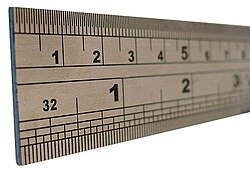Unit of length
This article needs additional citations for verification. (October 2012) |

A unit of length refers to any arbitrarily chosen and accepted reference standard for measurement of length. The most common units in modern use are the metric units, used in every country globally. In the United States the U.S. customary units are also in use. British Imperial units are still used for some purposes in the United Kingdom and some other countries. The metric system is sub-divided into SI and non-SI units.[1][2][3]
History
[edit]Before the establishment of the decimal metric system in France during the French Revolution in the late 18th century,[4] many units of length were based on parts of the human body.[5][6]
The Nippur cubit was one of the oldest known units of length. The oldest known metal standard for length corresponds to this Sumerian unit and dates from 2650 BCE.[7][8] This copper bar was discovered in Nippur, on the banks of the Euphrates, and is kept in the Istanbul Archaeological Museum. Archaeologists consider that this 51.85 centimetres long unit was the origin of the Roman foot. Indeed, the Egyptians divided the Sumerian cubit into 28 fingers and 16 of these fingers gave a Roman foot of 29.633 cm.[8][6]Metric system
[edit]SI
[edit]The base unit in the International System of Units (SI) is the meter, defined as "the length of the path travelled by light in vacuum during a time interval of 1⁄299792458 seconds."[9] It is approximately equal to 1.0936 yd. Other SI units are derived from the meter by adding prefixes, as in millimeter or kilometer, thus producing systematic decimal multiples and submultiples of the base unit that span many orders of magnitude. For example, a kilometer is 1000 m.
Non-SI
[edit]In the centimeter–gram–second system of units, the basic unit of length is the centimeter, or 1⁄100 of a meter. Other non-SI units are derived from decimal multiples of the meter.
| Name | Symbol | SI value |
|---|---|---|
| fermi | fm | 1 femtometer |
| ångström | Å | 100 picometers |
| micron | μm | 1 micrometer |
| Norwegian/Swedish mil or myriameter | 10,000 meters | |
| x unit | xu | 0.1 picometer |
Imperial/U.S.
[edit]The basic unit of length in the imperial and U.S. customary systems is the yard, defined as exactly 0.9144 m by international treaty in 1959.[2][10]
Common imperial units and U.S. customary units of length include:[11]
- thou or mil (1⁄1000 of an inch)
- inch (25.4 mm)
- foot (12 inches, 0.3048 m)
- yard (3 feet, 0.9144 m)
- (terrestrial) mile (5280 feet, or 1760 yards 1609.344 m)
- (land) league 3 miles (4,800 m)
Marine
[edit]In addition, the following are used by sailors:
- fathom (for depth; only in non-metric countries) (2 yards = 1.8288 m)
- nautical mile (one minute of arc of latitude = 1852 m)
Aviation
[edit]Aviators use feet for altitude worldwide (except in Russia and China) and nautical miles for distance.[citation needed]
Surveying
[edit]
Surveyors in the United States continue to use:
- chain (22 yards, or 20.1168 m)
- rod (also called pole or perch) (quarter of a chain, 51⁄2 yards, or 5.0292 m)
Australian building trades
[edit]The Australian building trades adopted the metric system in 1966 and the units used for measurement of length are meters (m) and millimeters (mm). Centimeters (cm) are avoided as they cause confusion when reading plans. For example, the length two and a half meters is usually recorded as 2500 mm or 2.5 m; it would be considered non-standard to record this length as 250 cm.[12][13]
Surveyor's trade
[edit]American surveyors use a decimal-based system of measurement devised by Edmund Gunter in 1620. The base unit is Gunter's chain of 66 feet (20 m) which is subdivided into 4 rods, each of 16.5 ft or 100 links of 0.66 feet. A link is abbreviated "lk", and links "lks", in old deeds and land surveys done for the government.
Science
[edit]Astronomy
[edit]Astronomical measure uses:
- Earth radius R🜨 ≈ 6,371 km[14]
- Lunar distance LD ≈ 384402 km.[15] Average distance between the center of Earth and the center of the Moon.
- astronomical unit au. Defined as 149597870700 m.[16] Approximately the distance between the Earth and Sun.
- light-year ly ≈ 9460730472580.8 km. The distance that light travels in a vacuum in one Julian year.[17]
- parsec pc ≈ 30856775814671.9 km or about 3.26156 ly
- Hubble length 14.4 billion light-years or 4.55 gigaparsecs
Physics
[edit]In atomic physics, sub-atomic physics, and cosmology, the preferred unit of length is often related to a chosen fundamental physical constant, or combination thereof. This is often a characteristic radius or wavelength of a particle. Some common natural units of length are included in this table:
| Atomic property | Symbol | Length, in meters | Reference |
|---|---|---|---|
| The classical electron radius | re | 2.817940285(31)×10−15 | [18] |
| The Compton wavelength of the electron | λC | 2.426310215(18)×10−12 | [18] |
| The reduced Compton wavelength of the electron | 3.8615926764(18)×10−13 | [19] | |
| The Compton wavelength (or reduced Compton wavelength) of any fundamental particle | |||
| The Bohr radius of the hydrogen atom (Atomic unit of length) | a0 | 5.291772083(19)×10−11 | [18] |
| The reduced wavelength of hydrogen radiation | 1 / R∞ | 9.112670505509(83)×10−8 | [18] |
| The Planck length | 𝓁P | 1.616199(97)×10−35 | [20] |
| Stoney unit of length | lS | 1.381×10−35 | |
| Quantum chromodynamics (QCD) unit of length | lQCD | 2.103×10−16 | |
| Natural units based on the electronvolt | 1 eV−1 | 1.97×10−7 |
Archaic
[edit]Archaic units of distance include:
- cana
- cubit
- rope
- league
- li (China)
- pace (the "double pace" of about 5 feet used in Ancient Rome)
- verst (Russia)
Informal
[edit]In everyday conversation, and in informal literature, it is common to see lengths measured in units of objects of which everyone knows the approximate width. Common examples are:
- Double-decker bus (9.5–11 meters in length)
- American football field (100 yards in length)
- Thickness of a human hair (around 80 micrometers)
Other
[edit]Horse racing and other equestrian activities keep alive:
- furlong = 1⁄8 mile (201.168 m)
- horse length ≈ 8 feet (2.4 m)
See also
[edit]- List of conversion factors § Length
- List of examples of lengths
- List of unusual units of measurement § Length
- Medieval weights and measures
- Orders of magnitude (length)
- System of measurement
- Units of measurement
References
[edit]- ^ Cardarelli, François (2003). Encyclopaedia of Scientific Units, Weights, and Measures: Their SI Equivalences and Origins. Springer. ISBN 9781852336820.
- ^ a b Hinkelman, Edward G.; Sibylla Putzi (2005). Dictionary Of International Trade: Handbook Of The Global Trade Community. World Trade Press. p. 245. ISBN 9781885073723.
- ^ Judson, Lewis Van Hagen (1960). Units of Weight and Measure (United States Customary and Metric): Definitions and Tables of Equivalents, Issue,233. U.S. Department of Commerce, National Bureau of Standards. pp. 3–4. Retrieved 16 October 2012.
- ^ Débarbat, Suzanne; Quinn, Terry (1 January 2019). "Les origines du système métrique en France et la Convention du mètre de 1875, qui a ouvert la voie au Système international d'unités et à sa révision de 2018". Comptes Rendus Physique. The new International System of Units / Le nouveau Système international d’unités (in French). 20 (1): 6–21. Bibcode:2019CRPhy..20....6D. doi:10.1016/j.crhy.2018.12.002. ISSN 1631-0705.
- ^ Kaaronen, Roope O.; Manninen, Mikael A.; Eronen, Jussi T. (2023-06-02). "Body-based units of measure in cultural evolution". Science. 380 (6648): 948–954. Bibcode:2023Sci...380..948K. doi:10.1126/science.adf1936. PMID 37262170.
- ^ a b "Du pied au mètredu marc au kiloL'histoire des unités des poids et mesuresévoquée par quelques objets emblématiques descollections du Musée d'histoire des sciences" (PDF). June 2010. p. 2.
- ^ Duran, Zaide; Aydar, Umut (July 2012). "Digital modeling of world's first known length reference unit: The Nippur cubit rod". Journal of Cultural Heritage. 13 (3): 352–356. doi:10.1016/j.culher.2011.12.006.
- ^ a b Z. Duran; U. Aydar (2008). "Measurement and 3D modelling of an ancient measuring device: Nippur Cubit Rod" (PDF). The International Archives of the Photogrammetry, Remote Sensing and Spatial Information Sciences. XXXVII: 265.
- ^ "17th General Conference on Weights and Measures (1983), Resolution 1". Retrieved 2012-09-19.
- ^ Donald Fenna (2002). A dictionary of weights, measures, and units. Oxford University Press. pp. 130–131. ISBN 978-0198605225. Retrieved 8 January 2012.
- ^ Cardarelli 2003, pp. 29–30
- ^ Wilks, Kevin Joseph. (1992). Metrication in Australia : a review of the effectiveness of policies and procedures in Australia's conversion to the metric system. Australia. Department of Industry, Technology, and Commerce. Canberra: Australian Govt. Pub. Service. p. 94. ISBN 0-644-24860-2. OCLC 27702954.
- ^ "Metrication in Australia" (PDF).
- ^ Moritz, H. (March 2000). "Geodetic Reference System 1980". Journal of Geodesy. 74 (1): 128–133. Bibcode:2000JGeod..74..128.. doi:10.1007/s001900050278. S2CID 195290884.
- ^ Battat, J. B. R.; Murphy, T. W.; Adelberger, E. G. (January 2009). "The Apache Point Observatory Lunar Laser-ranging Operation (APOLLO): Two Years of Millimeter-Precision Measurements of the Earth-Moon Range". Astronomical Society of the Pacific. 121 (875): 29–40. Bibcode:2009PASP..121...29B. doi:10.1086/596748. JSTOR 10.1086/596748.
- ^ Geoff Brumfiel (14 Sep 2012). "The astronomical unit gets fixed: Earth–Sun distance changes from slippery equation to single number". Retrieved 14 Sep 2012.
- ^ The IAU and astronomical units, International Astronomical Union, retrieved 2008-07-05
- ^ a b c d Quinn, T.J.; Leschiutta, S.; Tavella, P. (August 2000). Recent advances in metrology and fundamental constants. Amsterdam; Washington, DC: IOS Press, 2001. Proceedings of the International School of Physics "Enrico Fermi". pp. 142–143. ISBN 9781586031671.
- ^ "Compton wavelength over 2 pi". The NIST Reference on Constants, Units, and Uncertainty. NIST. Retrieved 15 October 2012.
- ^ "Planck length". The NIST Reference on Constants, Units, and Uncertainty. NIST. Retrieved 15 October 2012.
Further reading
[edit]- Whitelaw, Ian (2007). A Measure of All Things: The Story of Man and Measurement. Macmillan. ISBN 9780312370268.


 French
French Deutsch
Deutsch